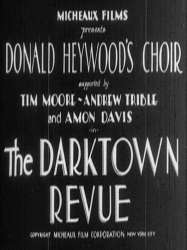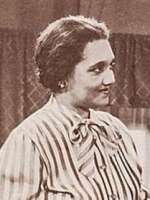Tim Moore is a Actor American born on 9 december 1887 at Rock Island (USA)

Tim Moore (9 December 1887 – 13 December 1958) was an American vaudevillian and comic actor of the first half of the 20th century. He gained his greatest recognition in the starring role of George "Kingfish" Stevens in the CBS television series Amos 'n' Andy. He proudly stated, "I've made it a point never to tell a joke on stage that I couldn't tell in front of my mother."
Moore was born Harry Roscoe Moore in Rock Island, Illinois, one of 13 children of Harry and Cynthia Moore. His father was a night watchman at a brewery. Tim Moore dropped out of grammar school to work at odd jobs in town and even danced for pennies in the streets with his friend, Romeo Washburn.
In 1898, Moore and Washburn went into vaudeville in an act called "Cora Miskel and Her Gold Dust Twins." It was booked by agents and travelled through the United States and even Great Britain. By 1904, the act had performed with the Barnum & Bailey Circus. As Moore and Washburn grew older, the act became less effective and Miss Miskel sent them back to their parents in Rock Island. Shortly after this, Moore joined the medicine show of "Doctor Mick" (Charles S. Mick), who sold a patented quack remedy called Pru-ri-ta. Doctor Mick travelled through the Midwestern states, with songs and dances provided by Moore and four Kickapoo Indians. The young man also worked in a carnival sideshow and gave guided tours as a "native" tour guide in Hawaii.
Boxing and Vaudeville Years
Moore left Doctor Mick, first to become a stableboy and later a jockey. He also tried his hand as a boxer. He returned to performing about 1906, with a troupe of minstrels called "The Rabbit's Foot Company." By 1908, he was back in vaudeville and had met and married his first wife, Hester. They performed as a team, "The Moores - Tim & Hester", appearing in the United States and abroad. In 1910, the couple was part of an act called the Four Moores. They next performed together in "Georgia Sunflowers," a minstrel show that played the southern vaudeville circuit. The Moores drew glowing reviews, Hester for her singing and Tim for his comedy. By 1914, both Moores were co-stars of an act that was billed as Tim Moore and Tom Delaney & Co.. Tim played the tuba and Hester played drums as part of a band. Moore's own stock company was responsible for all aspects of it. The couple toured China, Japan, Australia, New Zealand, the Fiji Islands and Hawaii with a vaudeville troupe. The marriage ended in 1915, and in September, Moore married a vaudeville actress named Gertrude Brown. After more than a year on the road in vaudeville in the United States, the Hawaiian Islands, Australia and New Zeeland, he returned to boxing as "Young Klondike", training in New Zealand. He fought there and in Australia, England, and Scotland. Before this, Moore fought as "Kid Klondike" in the US, with Jack Johnson and Sam Langford as some of his opponents. Moore also made his way into films by 1915, playing the part of an egotistical musician in His Inspiration. While Tim and Gertie were entertaining in New Zealand, a story in The Evening Post from 28 May 1917, went on to say, "Another "star" item will be that of Tim and Gertie Moore, who have earned a big reputation in America, and were booked for Fuller's direct from the well-known Orpheum circuit." Moore became well known for his one-man presentation of Uncle Tom's Cabin, where he would play the role of both Simon Legree and Uncle Tom, applying white chalk to half his face, and burnt cork to the other. Moore literally took his one man act into the street of San Jose, California, for the sale of War Stamps in 1918.
Having made $141,000 with his fists, in 1921 Moore and his wife returned to performing full-time in vaudeville. He formed his Chicago Follies troupe and was a favorite on the Theater Owners Bookers Association vaudeville circuit during the "Roaring Twenties" period. In 1923, Moore and his wife co-starred with Sandy Burns, Walter Long, and Bobby Smart in a silent film comedy, His Great Chance (North State Films). The following year, the Moores toured vaudeville together in "Aces and Queens". Subsequently, he went on tour as one of the stars of producer Edward E. Daley's "black and white musical comedy sensation,," Rarin' to Go, for three seasons on the Columbia Burlesque Wheel (1925, 1926 and 1927 editions).
Broadway Comedian
In June 1925, Tim Moore made his Broadway debut as the star of Lucky Sambo (based on "Aces and Queens'). However, the show closed after only a few performances. He was a success in burlesque in the mid 1920s with the hit show Rarin' to Go, followed by a return to vaudeville in 1927 with The Southland Revue. Moore wrote all of his own material and also did some writing for other performers; a Moore skit called, Not a Fit Night for Man nor Beast, was bought by W.C. Fields. He also did some writing for the radio show of the Two Black Crows comedy team. Moore was brought to New York to sign a writing contract but before this was done, Charles Mack of the team was killed in an auto accident, thus ending the act. Moore wrote sketches which became part of Lew Leslie's "Blackbirds" revues as well.
In 1928, Moore took time off from his vaudeville bookings to try his luck once more on the Great White Way – Broadway. This time he met with enormous success as the star comedian of Lew Leslie's hit musical comedy revue, the Blackbirds of 1928. Moore's co-stars were singers Adelaide Hall and Aida Ward and renowned tap dancer Bill "Bojangles" Robinson. The hit musical scored high in Paris and London as well as on the road throughout the states. In 1931, Moore and his then vaudeville straight man, Andrew Tribble, performed one of their funniest routines in Oscar Micheaux's first talking picture, The Darktown Revue. After a disagreement with Lew Leslie, Moore starred in two unsuccessful Broadway revues for other producers, Fast and Furious (1931), and The Blackberries of 1932. In the former, Moore wrote some of the skits along with his friend and co-star Zora Neale Hurston. Moore and fellow comedian "Morton" (i.e., Mantan Moreland) left the show in April 1932, refusing to perform what were termed "dirty lines". Needing each other, he and Leslie patched up their differences and Moore resumed his position as star comedian in the Blackbirds revues of 1934, 1935, 1936, 1937, and 1939. Politics played a role in the demise of the 1936 edition of the Blackbirds, causing the London run to be shut down. At the time the troupe was booked in the United Kingdom, King Edward VIII had just abdicated the British throne for love of American Wallis Simpson. There was a wave of anti-Americanism, with women picketing performances of the Blackbirds, carrying signs disparaging American women. In this last of the Blackbirds (1939), the principal singing star was Lena Horne. Moore's last Broadway show was Harlem Cavalcade (1942), produced by Ed Sullivan and Noble Sissle. During the late 1930s and early 1940s, Moore was one of the top comedians headlining at the Apollo Theater in Harlem. He also performed on radio as a dramatic actor.
In 1946, he starred as Bumpsie in the musical comedy film, Boy! What a Girl!. He made some appearances on Ed Sullivan's television show, Toast of the Town, and at the Apollo Theater; Moore then retired from show business. His wife Gertrude having died in 1934, Moore settled down with his third wife, Benzonia Davis Moore (1889–1956), in his home town of Rock Island, working the night shift at the Servus Rubber company, where boots and shoes were made. The couple was married in 1941 and initially made their home in Baltimore.
Source : Wikidata
Tim Moore

- Infos
- Photos
- Best films
- Family
- Characters
- Awards
Birth name Harry Roscoe Moore
Nationality USA
Birth 9 december 1887 at Rock Island (USA)
Death 13 december 1958 (at 71 years) at Los Angeles (USA)
Nationality USA
Birth 9 december 1887 at Rock Island (USA)
Death 13 december 1958 (at 71 years) at Los Angeles (USA)
Biography
Early yearsMoore was born Harry Roscoe Moore in Rock Island, Illinois, one of 13 children of Harry and Cynthia Moore. His father was a night watchman at a brewery. Tim Moore dropped out of grammar school to work at odd jobs in town and even danced for pennies in the streets with his friend, Romeo Washburn.
In 1898, Moore and Washburn went into vaudeville in an act called "Cora Miskel and Her Gold Dust Twins." It was booked by agents and travelled through the United States and even Great Britain. By 1904, the act had performed with the Barnum & Bailey Circus. As Moore and Washburn grew older, the act became less effective and Miss Miskel sent them back to their parents in Rock Island. Shortly after this, Moore joined the medicine show of "Doctor Mick" (Charles S. Mick), who sold a patented quack remedy called Pru-ri-ta. Doctor Mick travelled through the Midwestern states, with songs and dances provided by Moore and four Kickapoo Indians. The young man also worked in a carnival sideshow and gave guided tours as a "native" tour guide in Hawaii.
Boxing and Vaudeville Years
Moore left Doctor Mick, first to become a stableboy and later a jockey. He also tried his hand as a boxer. He returned to performing about 1906, with a troupe of minstrels called "The Rabbit's Foot Company." By 1908, he was back in vaudeville and had met and married his first wife, Hester. They performed as a team, "The Moores - Tim & Hester", appearing in the United States and abroad. In 1910, the couple was part of an act called the Four Moores. They next performed together in "Georgia Sunflowers," a minstrel show that played the southern vaudeville circuit. The Moores drew glowing reviews, Hester for her singing and Tim for his comedy. By 1914, both Moores were co-stars of an act that was billed as Tim Moore and Tom Delaney & Co.. Tim played the tuba and Hester played drums as part of a band. Moore's own stock company was responsible for all aspects of it. The couple toured China, Japan, Australia, New Zealand, the Fiji Islands and Hawaii with a vaudeville troupe. The marriage ended in 1915, and in September, Moore married a vaudeville actress named Gertrude Brown. After more than a year on the road in vaudeville in the United States, the Hawaiian Islands, Australia and New Zeeland, he returned to boxing as "Young Klondike", training in New Zealand. He fought there and in Australia, England, and Scotland. Before this, Moore fought as "Kid Klondike" in the US, with Jack Johnson and Sam Langford as some of his opponents. Moore also made his way into films by 1915, playing the part of an egotistical musician in His Inspiration. While Tim and Gertie were entertaining in New Zealand, a story in The Evening Post from 28 May 1917, went on to say, "Another "star" item will be that of Tim and Gertie Moore, who have earned a big reputation in America, and were booked for Fuller's direct from the well-known Orpheum circuit." Moore became well known for his one-man presentation of Uncle Tom's Cabin, where he would play the role of both Simon Legree and Uncle Tom, applying white chalk to half his face, and burnt cork to the other. Moore literally took his one man act into the street of San Jose, California, for the sale of War Stamps in 1918.
Having made $141,000 with his fists, in 1921 Moore and his wife returned to performing full-time in vaudeville. He formed his Chicago Follies troupe and was a favorite on the Theater Owners Bookers Association vaudeville circuit during the "Roaring Twenties" period. In 1923, Moore and his wife co-starred with Sandy Burns, Walter Long, and Bobby Smart in a silent film comedy, His Great Chance (North State Films). The following year, the Moores toured vaudeville together in "Aces and Queens". Subsequently, he went on tour as one of the stars of producer Edward E. Daley's "black and white musical comedy sensation,," Rarin' to Go, for three seasons on the Columbia Burlesque Wheel (1925, 1926 and 1927 editions).
Broadway Comedian
In June 1925, Tim Moore made his Broadway debut as the star of Lucky Sambo (based on "Aces and Queens'). However, the show closed after only a few performances. He was a success in burlesque in the mid 1920s with the hit show Rarin' to Go, followed by a return to vaudeville in 1927 with The Southland Revue. Moore wrote all of his own material and also did some writing for other performers; a Moore skit called, Not a Fit Night for Man nor Beast, was bought by W.C. Fields. He also did some writing for the radio show of the Two Black Crows comedy team. Moore was brought to New York to sign a writing contract but before this was done, Charles Mack of the team was killed in an auto accident, thus ending the act. Moore wrote sketches which became part of Lew Leslie's "Blackbirds" revues as well.
In 1928, Moore took time off from his vaudeville bookings to try his luck once more on the Great White Way – Broadway. This time he met with enormous success as the star comedian of Lew Leslie's hit musical comedy revue, the Blackbirds of 1928. Moore's co-stars were singers Adelaide Hall and Aida Ward and renowned tap dancer Bill "Bojangles" Robinson. The hit musical scored high in Paris and London as well as on the road throughout the states. In 1931, Moore and his then vaudeville straight man, Andrew Tribble, performed one of their funniest routines in Oscar Micheaux's first talking picture, The Darktown Revue. After a disagreement with Lew Leslie, Moore starred in two unsuccessful Broadway revues for other producers, Fast and Furious (1931), and The Blackberries of 1932. In the former, Moore wrote some of the skits along with his friend and co-star Zora Neale Hurston. Moore and fellow comedian "Morton" (i.e., Mantan Moreland) left the show in April 1932, refusing to perform what were termed "dirty lines". Needing each other, he and Leslie patched up their differences and Moore resumed his position as star comedian in the Blackbirds revues of 1934, 1935, 1936, 1937, and 1939. Politics played a role in the demise of the 1936 edition of the Blackbirds, causing the London run to be shut down. At the time the troupe was booked in the United Kingdom, King Edward VIII had just abdicated the British throne for love of American Wallis Simpson. There was a wave of anti-Americanism, with women picketing performances of the Blackbirds, carrying signs disparaging American women. In this last of the Blackbirds (1939), the principal singing star was Lena Horne. Moore's last Broadway show was Harlem Cavalcade (1942), produced by Ed Sullivan and Noble Sissle. During the late 1930s and early 1940s, Moore was one of the top comedians headlining at the Apollo Theater in Harlem. He also performed on radio as a dramatic actor.
In 1946, he starred as Bumpsie in the musical comedy film, Boy! What a Girl!. He made some appearances on Ed Sullivan's television show, Toast of the Town, and at the Apollo Theater; Moore then retired from show business. His wife Gertrude having died in 1934, Moore settled down with his third wife, Benzonia Davis Moore (1889–1956), in his home town of Rock Island, working the night shift at the Servus Rubber company, where boots and shoes were made. The couple was married in 1941 and initially made their home in Baltimore.
Usually with
Filmography of Tim Moore (2 films)
Actor

Boy! What a Girl! (1947)
, 1h10Genres Musical
Actors Tim Moore, Sheila Guyse
Roles Bumpsie
Rating56%





Would-be theatrical producer Jim Walton is planning a new show that will feature bandleader Slam Stewart and the comic female impersonator Bumpsie (Tim Moore). Mr. Cummings, the wealthy father of Jim’s girlfriend Cristola, has agreed to finance half of the show if the famous Parisian impresario Madame Deborah will provide the second half of the funding. When word arrives that Madame Deborah’s arrival from France has been delayed, Bumpsie is brought in to keep Mr. Cummings occupied. Mr. Cummings, however, is unaware that Bumpsie is a man in drag and he falls in love with him. The real Madame Deborah unexpectedly arrives early and passes herself off as Mrs. Martin. Two other would-be suitors, impressed with Madame Deborah’s wealth, begin to pursue Bumpsie. A fundraising party for the show is held, where several musical acts arrive to perform. A pair of thugs attempt to kidnap Bumpsie, believing he is Madame Deborah, but he manages to escape. The real Madame Deborah identifies herself and agrees to finance Jim’s show, enabling him to achieve his professional goals and to marry Cristola.

The Darktown Revue (1931)
, 18minutesDirected by Oscar Micheaux
Origin USA
Genres Comedy, Musical
Themes Musical films
Actors Tim Moore
Rating48%





 Connection
Connection


